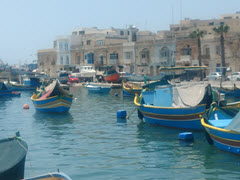
The ferry brought us to Valletta Harbour at about 11:00pm. After disembarking, finding the car from the hotel, and experiencing the pastoral serenity (sarcasm) of driving in urban Malta, we arrived at the Grand Hotel Excelsior in Floriana around midnight. Nevertheless we woke up bright and early to tour Malta with Amy Pace, our hired guide for the day, starting on time at 08:30 AM.
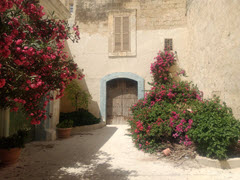
Over the winter, I had worked with Amy to set up an ambitious itinerary of Maltese sites: the Hypogeum (a neolithic necropolis) and the neolithic temple at Haggar Qim, Lunch at La Reggia in the picturesque Marsaxlokk fishing village (pictured above), then the mostly intact medieval town of Mdina, and back to Valletta for the magnificent Co-Cathedral of St John and the National Archaeology Museum. Amy's services made our day the great success that it was and I recommend her highly to anyone planning a trip to Malta.
The Hypogeum came first. This is a very delicate and ancient site underneath a busy urban setting. They only admit 10 people at a time and you must buy tickets beforehand. Amy helped us with that critical knowledge. Photos are not permitted, so I have none to show here.
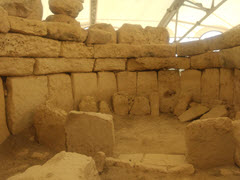
Then we went to the incredible stone age temple at Haggar Qim. This is built of massive blocks of stone in the same fashion as Stonehenge or Bru na Boinne. It is very complex, and older than the pyramids. The sense of immensity, of time, of space, of human effort, is inescapable. This was built in the stone age! More significantly, unlike any other megalithic or other neolithic or even Bronze Age site, there is no evidence of an all-powerful king or priesthood.
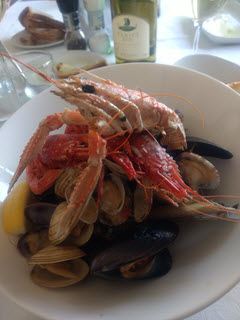
After Haggar Qim, we went to the picturesque fishing village of Marsaxlokk (pronounced MAR-sa-shlock), pictured at the top of this page.
Amy guided us to La Reggia for lunch: There was an amuse-bouche of crudo tuna, then I had the assiete of local shellfish, Lorna had the sea bass fillet puttanesca, and Melissa had the excellent tempura veggies.
The shellfish assiete included shrimp, clams, razor clams, mussels, langoustine, and more perfectly fresh sea-denizens that I had never encountered. The tempura was perfectly light and crisp, but we were also among the first diners of the day. We enjoyed a local Maltese wine with it, of course.

The next stop was the nearly completely intact medieval town of Mdina (site of some Game of Thrones scenes that Melissa recognized). Mdina is a charming, quiet, unsettling area with clear Moorish architectural influences.
Amy had all sorts of stories of local eccentricities (I'm still haunted by the story of the lone princess, and the one of the handful of surviving nonagenarian nuns), as well as clear archaeological tips about how to recognize construction of different periods, etc. We spent a lot of time exploring and marvelling at this beautiful and weird place.
Then we hastened back to Valletta to see th magnificent St John’s Co-Cathedral and the National Archaeology Museum.
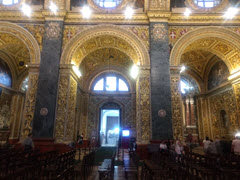
St John's is a co-cathedral because Mdina also has a co-cathedral of equal significance in the same archdiocese. It's complicated.
St. John's was built as the new home of the Order of St John and the Knights Hospitaller. It was all about wealth and power, so it competes with or exceeds St Peter's Basilica in Rome for grandeur, but in no way approaches the latter's divine spiritual sublimity.
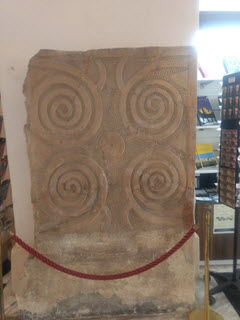
Amy is efficient. She knew our interests and expertly guided us through the co-cathedral with enough time for a quick visit to the National Archaeological Museum. Remember that we started our day with two neolithic sites before moving on to a medieval site and a 16th-century cathedral - clearly she understood our interest in Malta's history. I must return some day to give more time to the museum, and to Haggar Qim, Ggantija, Tarxien, and the numerous other ancient sites on these small islands.
When Amy's time was up, she brought us back to the hotel, where we freshened up and set our for another memorable dinner.
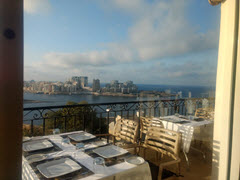
After freshening up, we hired a driver from the hotel to bring us to dinner at Giannini, just a short distance away in Valletta.
Gianinni has been in business for 30 years, so they're doing a lot of things right. At the top of the list is the location and the view - the restaurant is on the top floor of a building with a nice view of Marsamxett Harbour.
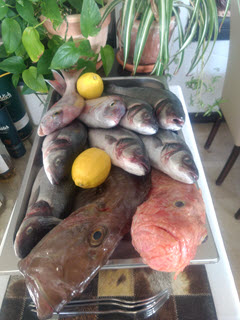
Naturally we were greeted with a large platter of fresh sea bass and other fish, which left the ladies somewhat nonplussed. I selected one for myself and another for Lorna, and none for the vegetarian Melissa, and the distressing view of deceased piscenes was quickly dispensed with.
I don't think that the Italian and Maltese penchant for showing the fish is absolutely superior in principle to the American method of simply trusting that the fish is fresh or never returning to the restaurant. But it does show indisputably that the house does have some fresh fish, and if they have a little then they can get a lot, so it provides some assurance that your fish was never frozen.
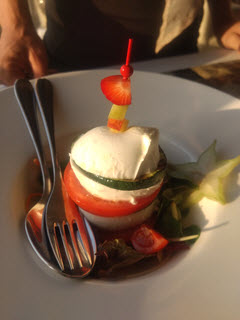
We started with a re-imagined Caprese salad. I'm not sure that the elegant simplicity of a classic caprese needs any re-imagining, but Gianinni's interpetation was undeniably fresh and flavorful. This was a hint of things to come: excellent ingredients masterfully matched to the flavor and texture of other ingredients, and at peak freshness. Sometimes the look was a bit precious in our American eyes, but then maybe we're the barbarians in the room.
In any event, after the initial visual shock of the Sputnik-like form of the humble Caprese, we tucked into it and declared it a victory. Whatever the chef's artistic inclinations, s/he makes a very fine Caprese!
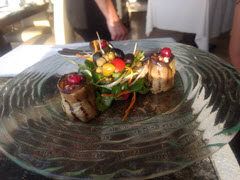
Then we had another salad, just because it sounded so good, and we'd had such a busy day that we were all hungry. This one was a carefully architected construct of two rollatini of grilled eggplant stuffed with herbed ricotta, flanking a riot of little grape tomatoes and olives on a bed of rapunzel, with some more colorful and flavorful bits that I don't remember. This was not just a riot of color; the flavors were all complementary and the textures all worked together.
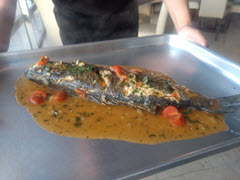
My sea bass was served headless out of respect for the ladies. It was otherwise whole, in a rich and delicate sauce. After being presented on a stainless steel platter, it was removed to tableside and filleted by the server in the Italian fashion that we had first witnessed in Venice, and then it was served on a fresh dinner plate.
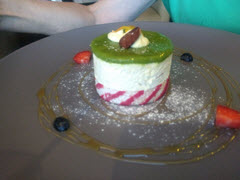
Lorna and Melissa could not resist dessert, especially when Lorna saw a reconstructed version of the Cassata alla Siciliana on the dessert menu. It did not look quilte as she had expected, but it sure was tasty and there were no leftovers to bring back to the hotel.
We'd had a full day of experience spanning five millennia of history, but there was still something lacking from my foodie discovery. I wanted to find some classical Maltese ingredient not common in other cuisines.
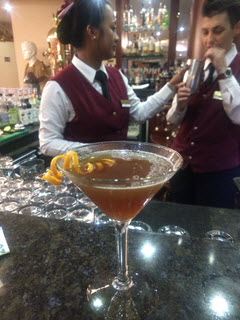
Of course I was running out of time and energy, and appetite. The Grand Excelsior hotel bar was the answer!
I discovered a carob liqueur on the bar. Carob trees grow wild on Malta, and they have provided great nutritional value during the many times that the island has been besieged. Now it is made into a liqueur, and that night Joy the bartender and I invented a cocktail to showcase that local specialty: The Marsamxett Cocktail.
We needed a very early night due to the 05:30 ferry boarding, so we went to sleep as early as we could wind down from the excitement of the day's adventures. Tomorrow we would be back to Sicily.
